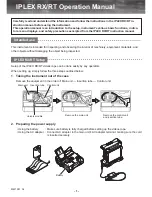
AMI Analyzer Manual
Installation and Operation
5
Installation and Operation
Receiving the analyzer
When you receive the instrument, check the package for evidence of damage and if any is found, contact
the shipper.
Do not install the sensor until the analyzer is completely installed, the gas lines are plumbed and the
electrical connections are all made; and sample or zero gas is ready to flow into it.
Installation.
This section contains important information to do with safety and installation. Please don’t skip it!
Do not open the sealed metallized T-2 or T-4 oxygen sensor bag or install the sensor until the analyzer is
completely installed, the gas lines are plumbed and the electrical connections are all made; and sample
or zero gas is ready to flow into it. If you do you will expose the sensor to so much oxygen in the air that
it will be saturated and may not come down to low levels for a very long time.
-------------------------Points to consider first!
------------------------------
Environment
– what is the temperature range going to be where the analyzer will be installed? If the
temperature is going to go below freezing, you need to place it in a temperature controlled meter building.
If this is not possible, you should really be using a heated 2010BR. Also, make sure it won’t get too hot in
the summer – you may need to ventilate or even air condition a building. Use a solar panel as a sunshield if
one is to be used. The standard temperature specification is 25
º
F to 115°F.
Sample conditions
– if your sample is hot and wet, you will need to keep water from condensing in the
sample line or analyzer. The AMI demister brings hot and wet gases back to ambient temperature and
allows the condensation and entrained liquids to fall back into the pipeline (no draining is necessary, unlike
a coalescing filter which requires routine maintenance). The Liquid rejection probe stops occasional slugs of
water from contaminating the analyzer, and acts as a check valve, so that if a compressor goes down
drawing a vacuum on the line, air is not drawn back into the analyzer through its vent. It is available with a
built-in pressure regulator for high pressure lines (up to 1200psig).









































